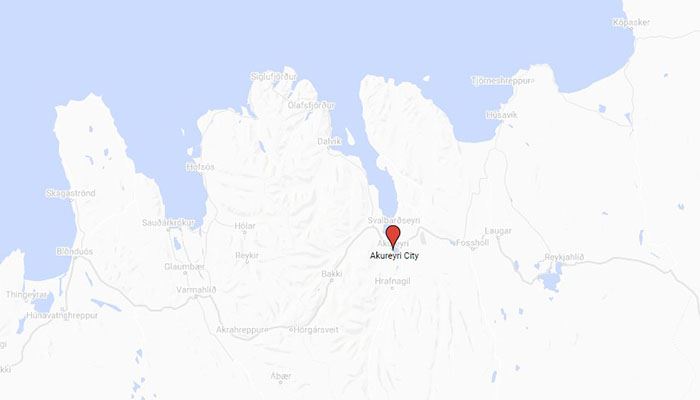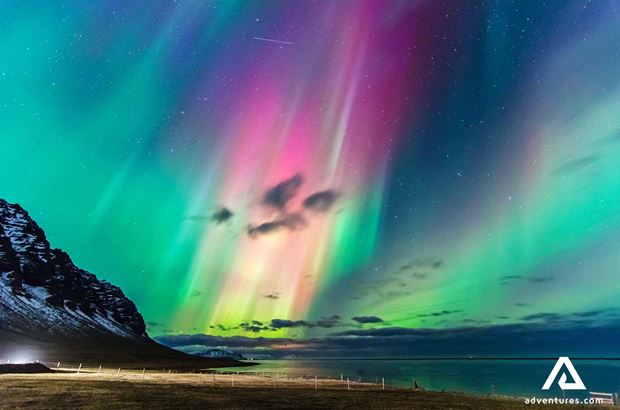If you're visiting the 'capital' of north Iceland, Akureyri, in the wintertime, you might be interested in a northern lights tour.
This is a very good area for spotting the aurora, and we wish you the best of luck!


Going out into the dark, frozen winter night to observe an unbelievable display of colors, light, and textures is like waking up in a fairy-tale full of mystery and magic.
You'll be picked up at your accommodation in Akureyri and drive out to the countryside or up to the mountains, away from the glow of electric lights and city sounds.
The northern lights are visible from September through to April but can only be seen on a clear night. If the cloud, weather, and atmospheric conditions are not suitable we cancel the tour.
The northern lights are one of those rare natural phenomenons that people all over the world feel excited about seeing. It is truly magical to see the northern lights dancing their brilliant patterns across the night sky when the northern hemisphere is approaching its time of almost total darkness. Seeing the glory of nature's color and magic is a majestic and never to be forgotten experience. At Extreme Iceland we want to give you the opportunity to chase the northern lights in a comfortable and fun way.
Some of the factors which can cause the cancellation of this northern lights tour are: the sky is too cloudy, a snow blizzard, or too high a temperature. We reserve the right to cancel the tour if the weather, road, or atmospheric conditions are not suitable.
Note: Sightings cannot be guaranteed even if the tour is operated. In case of no northern lights, a free second departure is offered the following evening. Please contact our sales team the day after your tour via email or phone. Be sure to contact before 15:00 so we can reserve your seat.
The name 'aurora' comes from the Latin word aurora which means "sunrise" and was the Roman goddess of dawn. Most auroras occur between 90 and 130 km above sea level. Charged particles are flung off the surface of the sun and are funneled down along m...)

The name 'aurora' comes from the Latin word aurora which means "sunrise" and was the Roman goddess of dawn.
Most auroras occur between 90 and 130 km above sea level.
Charged particles are flung off the surface of the sun and are funneled down along magnetic field lines towards the poles. The charged particles originate in the magnetosphere and solar wind and, on Earth, are directed by the Earth's magnetic field into the atmosphere.
It's not only the atmosphere that protects us from the power of the sun. The magnetic field of the earth also shields us from the full intensity of cosmic radiation and from potentially deadly forces emanating from the sun.
The latter include the solar wind, which is a steady stream of energetic particles; solar flares, which in minutes release as much energy as billions of hydrogen bombs; and explosions in the outer region, or corona, of the sun, which blast billions of tons of matter into space.
You can see visible reminders of the protection from the earth's magnetic field. Solar flares and explosions in the sun's corona trigger intense auroras, colorful displays of light visible in the upper atmosphere near earth's magnetic poles.
Still got questions about the tour? Hopefully you will find the answer here.
The Northern Lights are natural phenomena and we, unfortunately, cannot promise you will see them. Their appearance depends upon atmospheric and weather conditions.
For more information on the Northern Lights, please have a look at our Northern Lights tours.
We, unfortunately, do not have one simple answer to this question.
There isn’t just one single setting for your camera that ensures great photos. However, if you have manual options, you are probably best served with experimenting with various combinations of ISO, aperture, and exposure settings. As a rule of thumb, ISO setting between 800 and 3200, aperture between f/2 8 and f/5.6, and shutter speed at between 15 seconds and 30 seconds have proven effective.
A good thing to keep in mind, ISO setting between 800 and 3200, aperture between f/2.8 and f/5.6, and shutter speed between 15 seconds and 30 seconds have given great results.
Different combinations may give very different results. Higher ISO setting will allow you to capture faster exposures, but the downside to this might be for example grainier images.
If the shutter speed is above 15 seconds it will result in a slight star movement.
Wider angle lenses are usually more versatile in low light settings, but longer lenses give you different options for compositions. Make sure that you remove all lens filters, as they may distort images. You will probably get the best results with manual setting for infinite focal length.
Reimbursement is not given if the northern lights tour goes ahead and no lights are seen but we do offer you the change to join a Northern Lights Minibus tour free of charge.
Please contact our Customer Care to re-book your tour.
When Northern Lights tours are canceled it’s usually due to unfavorable weather conditions.
In that case, your options will be to:
Please go to the customer portal to re-book your tour or contact us by phone at +354 562 7000.
The northern lights are a pretty difficult thing to predict. We recommend you to check en.vedur.is to see the forecast and if the level is high and the skies are clear then it’s very likely that the tour is going ahead. We do update our website’s tour departure sheet with the information at 17:00 pm the latest. If your tour is canceled then you will receive an email from us.
If we think there is no chance at all of seeing the lights we will cancel the tour. We don’t want to bring you out and disappoint if there is no chance of the lights to be seen.
Yes, the guide on your tour will take a photo of you with the northern lights in the background.
These can be single or group photo’s and are free of charge.
The Northern Lights season is from late August until mid-April. However, if you want to increase your changes of seeing them, it is best to wait until the clear winter months of mid-September until March.
The northern lights depend on luck and weather if that is in your favor than you will be able to see the Aurora Borealis above the inviting streets of Reykjavík. Whether you see the lights or not they depend on two different factors. The first being the weather. If the sky is clear, no clouds, then you are halfway there to seeing the astonishing spectacle that is the Northern Lights (although light pollution can sometimes be a problem). Increased solar activity is the second half so, if these two merge together you may well be able to see the Northern Lights from Reykjavik.